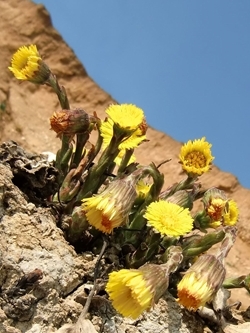Coltsfoot
 Coltsfoot (Tussilago farfara) is one of my favourite spring flowers, as bright and cheerful as any daffodil. I first noticed it on the southern cliffs of the Isle of Wight some years ago, and have since encountered it on all sorts of disturbed ground and fallow land including crop stubbles. It is widespread and common across Eurasia on almost every type of soil.
Coltsfoot (Tussilago farfara) is one of my favourite spring flowers, as bright and cheerful as any daffodil. I first noticed it on the southern cliffs of the Isle of Wight some years ago, and have since encountered it on all sorts of disturbed ground and fallow land including crop stubbles. It is widespread and common across Eurasia on almost every type of soil.
The lemon-yellow flowerheads usually appear in March, perfectly timed to offer nectar and pollen to queen bumblebees and other insects when they emerge after hibernation. At a glance coltsfoot might appear as a colony of short dandelions, but if you look closely the stems are thick and snake-like, covered in reddish scales and fine hairs. Another telltale characteristic is that there are no leaves, because the plant doesn’t produce them until later in the year.
In April the flowers give over to tufty-topped seeds, which are favoured by goldfinches for nest lining. Apparently Highlanders of yonder years used to gather coltsfoot seedheads and stuff bedding and mattresses with them too – good thing we invented polyester, as that sounds like hard work.
Coltsfoot seeds germinate in late summer to autumn, and first form a deep taproot, which is capable of penetrating a metre down into clay-rich soils. Next, the plant creates a network of rhizomes throughout the upper layer of soil over winter, and the flowering stems are sent up in early spring. As the flowers set seed, the hoof-shaped leaves for which it is named emerge. This habit of flowering before its leaves emerge earns it the nickname son-before-father!
The leaves are eaten as a food plant by the caterpillars of several species of moth. They are known to have some human medicinal value when prepared as syrups and tinctures and when smoked, particularly for sore throats, asthma and chest infections. Its scientific name, Tussilago farfara, is derived from the Latin tussis, which means cough. Somehow the Scots’ play on this is ‘tushylucky’ (I am trying to pronounce this in my head with a Scottish accent and can’t). I was interested to read that a sweet shop in Lancashire has been making and selling traditional coltsfoot rock candy for about a century. Made popular by its alleged treatment of colds and coughs, the rock is now recognised as a product of regional importance and is protected alongside other traditional culinary products like Wensleydale cheese and Kendal mint cake!
So, a plant of great value to the first pollinating insects of the year, to goldfinches, moths, and to those suffering from chest ailments. It occurs to me that, in the mania surrounding the current coronavirus outbreak, it might be more useful for people to panic-buy a load of coltsfoot rock instead of toilet roll and baked beans?
Jess Brooks
Advisory